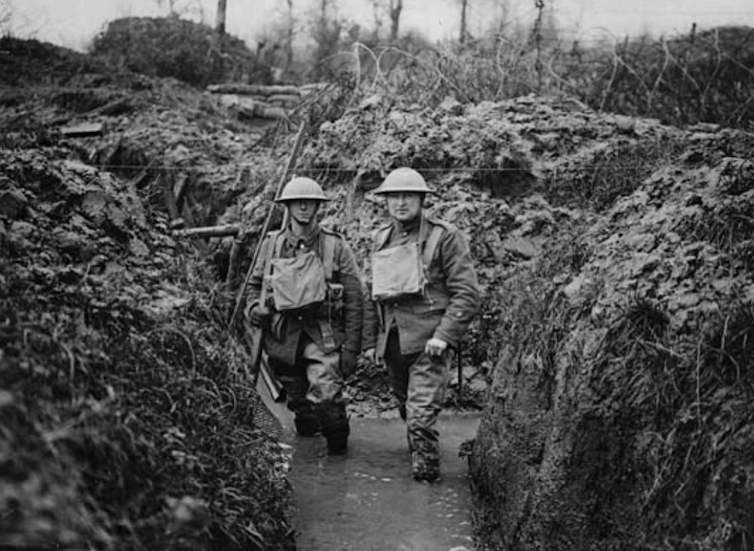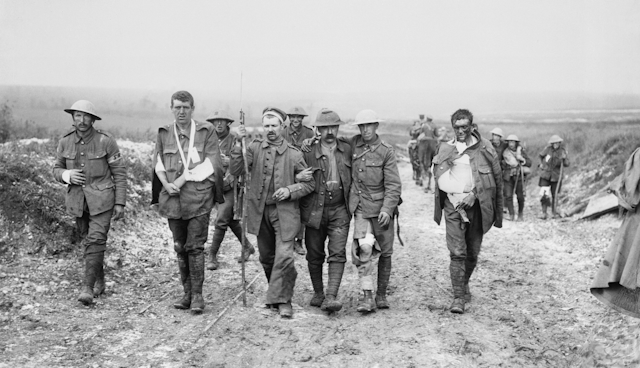Between 1914 and 1918 the British Empire amassed a force of nearly nine million men to go to war. Ravenous in its need to field soldiers, the dwindling professional British army was soon augmented by reserve forces, conscripts and civilian volunteers.
Most had limited to zero military experience and many men who entered service did not return home the same. Changed and often traumatised, the first world war represented a fracture point in soldiers’ personal histories. As a young Lieutenant Godfrey wrote to his mother in 1914, it was a strikingly “different existence” from which no one escaped unaltered.
My new book War Bodies focuses directly on this life-changing experience for British men, investigating their personal accounts. It focuses on the immediate and lasting impact of the war upon the bodies of soldiers, building up a mosaic of the physical experience of battle through their testimony. This illustrates the extent to which their physical bodies were perceived, controlled, transformed and abused by army leadership to secure victory.
Broken bodies
Take Private Silver, a pre-WWI recruit whose diary opens with his delight at his shiny red uniform. Bitter at having to exchange it for khaki in 1914, Silver turned his displeasure to the deplorable state of the food. He also discussed the shelling and fighting in vivid detail, yet one of the events to which he devotes significant space is the injustice of repeated punishment for trench foot in 1915.
I told him [the company sergeant] that I had no time to clean the mud off my clothes and my feet were more important so he sentenced me to seven days punishment which meant I had to do more dangerous and dirty jobs than the other lads, including going out into no-man’s land putting out barbed wire and cleaning latrines.
Aggrieved at his treatment, Silver protested the impossibility of adequate sanitary care as directed by the Royal Army Medical Corps (RAMC) while knee deep in mud and freezing water. No amount of whale oil could recover his bleeding feet, ironically worsened by each punishment for the perceived decline in his personal standards. The cycle continued until Silver was effectively crippled. Only once his fighting ability was clearly impaired was the cycle broken, his plight recognised and the punishments replaced with medical care.

Silver’s case illustrates a significant issue for many serving men in that the damage his body suffered was nothing to do with fighting the enemy. It was the armed forces he had sworn allegiance to that had continued to cause him harm.
As conscripts learned how to fight they became stronger and fitter, yet much of this was undone once they reached the battlefield and were wounded, maimed or killed.
As men battled the enemy during the war, they also fought the environments they inhabited, their own physical needs and desires, and crucially for this investigation, the military establishment that chose, trained and fielded them.
Objection and resistance
The battle for control over the British fighting body was often an ugly one, aggravated by the necessity to create soldiers from civilian volunteers and conscripts. Many of these men entered service with expectations and objections to traditional military control that was not the case with standard military recruits.
Cases of resistance were numerous, including the story of Private Roberts who led a mini mutiny in 1915 against military command over the deplorable state of the food or the rebellion of a training battalion of Welsh miners who refused to fall out due to a physically abusive officer. In another case, several men escaped through a window in 1916 to avoid unwanted inoculations enforced by their zealous commanding officer.
The physical efficiency of the soldier in battle meant significant interference in British soldiers’ bodies by the military. Training and discipline were singularly designed to keep the body fighting. Early responses to cases of shell-shock included directions to physically assault those afflicted in an effort to dispel their stupor. Private Roberts recounted how witnessing a man encouraged to hang himself for his physical weakness was later useful when he worked with the Royal Army Medical Corps.
Masculinity and physical ability were intertwined as demonstrations of “manliness” and self-worth became fixated on the body’s ability to fight. So it is unsurprising that the terror-induced paralysis of Private Archer at Ypres in 1917 led to questions of his worth as a soldier and a man. The impacts of these beliefs could be tragically fatal as in the case of wounded veteran Harry Green, who believed his injuries made him a burden on the state and ended his life after returning home in 1917.

Battle for the body
Few ended the first world war unscarred. Within the experiences of the millions who fought, there are abundant examples of the battle for the body, as the British military demanded more and more from their men to secure victory.
Investigating the war through the lens of physical experience is useful and insightful because the price of service was the extreme toll on the body. Much like the toll upon the mental health of serving men, the visible and invisible scars from battle would not fade easily or completely.
Weighed and measured, trained and transformed, broken and buried, the war saw the human body pushed beyond endurance as British soldiers fought interminably long campaigns in intolerable conditions and appalling weather. Many returned home mutilated, shell-shocked, mute or severely disabled, and some not at all. It is through these stories of physical experiences that historians can attempt to understand what existence was truly like for the soldiers of the first world war.
Now listen to our podcast here: World War I remembered

